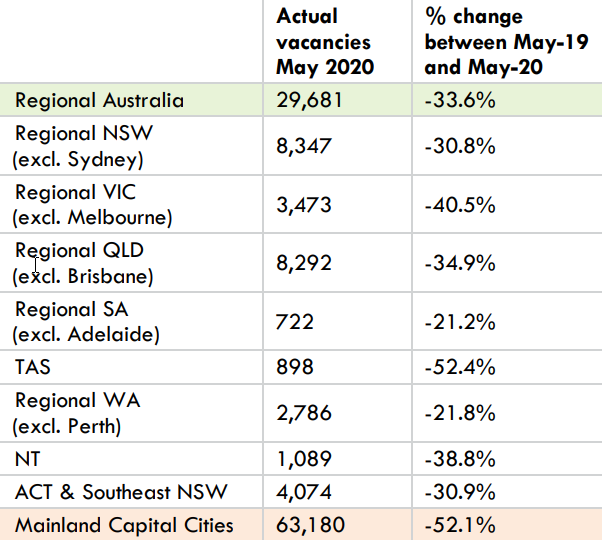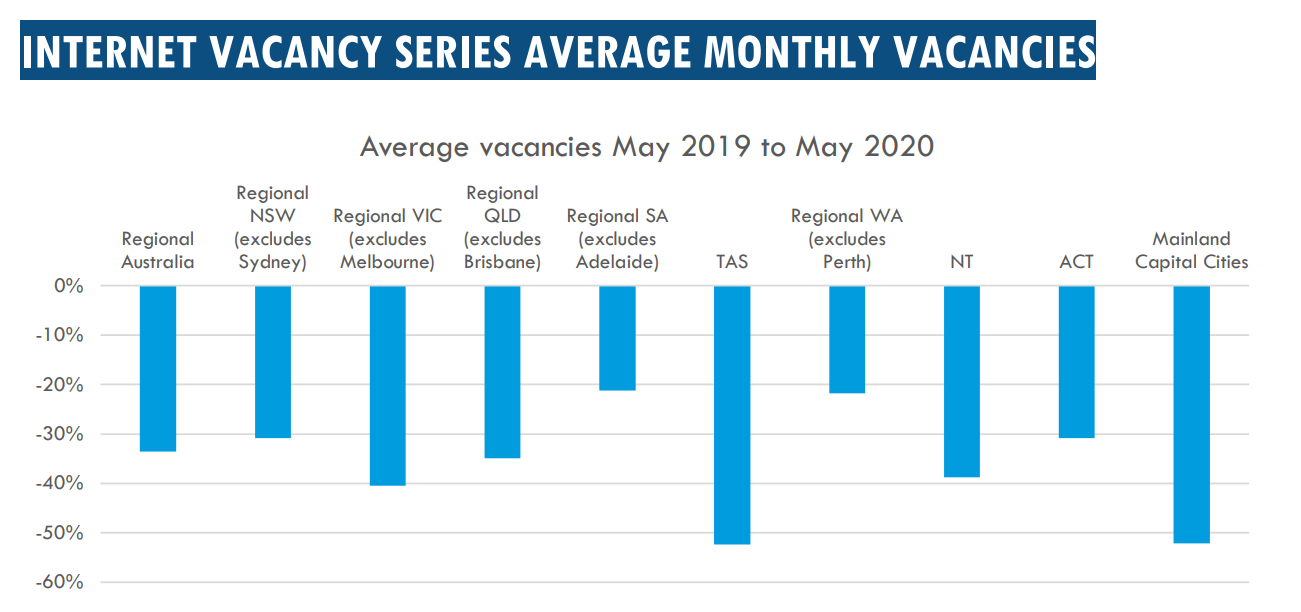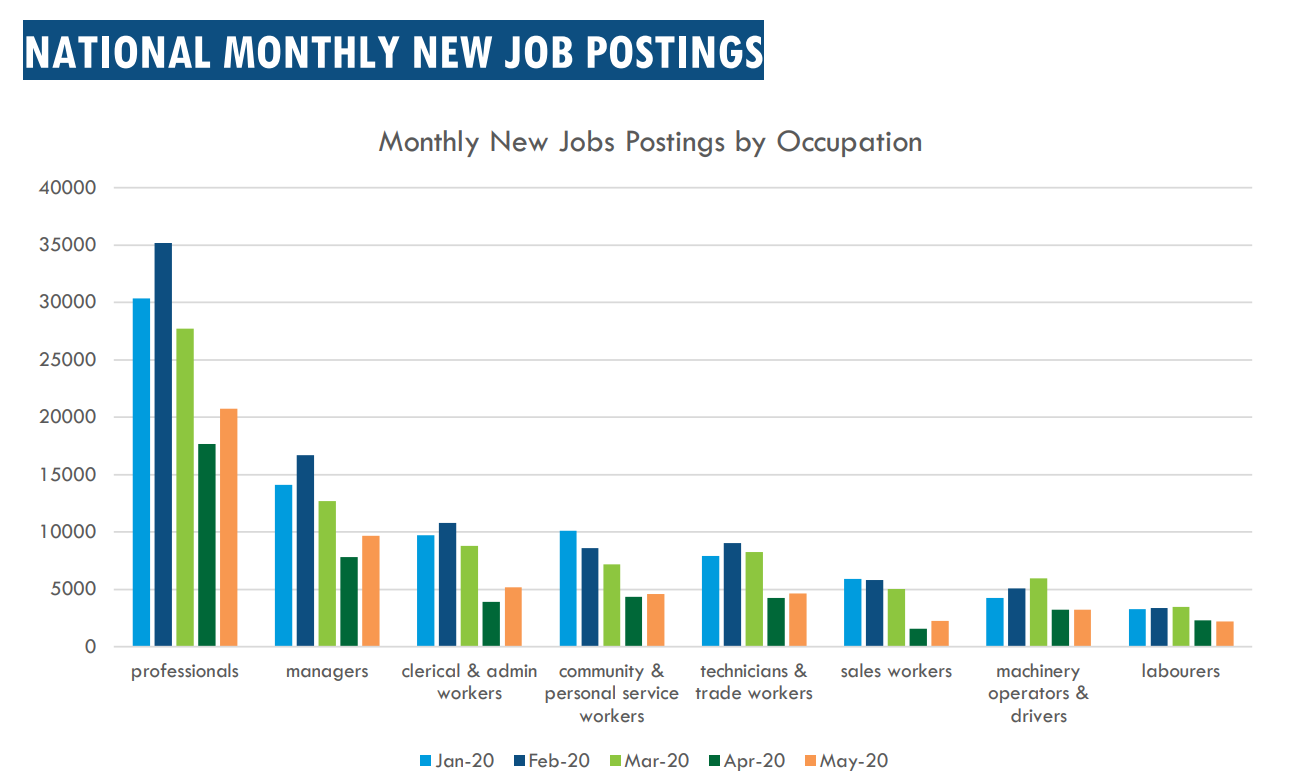By Chief Economist, Dr Kim Houghton
In May 2020 there were nearly 30,000 jobs advertised on the internet in regional Australia – outside the mainland state capitals. This value is a three-month average, so the sharp drop off from mid-March is partially hidden by strong regional vacancy numbers in early March. While this was a 33% fall on the same month in 2019, it does show that many regional employers are still looking for workers. In comparison, the number of job vacancies on the internet advertised by employers from the mainland state capitals fell by 52%.
In May 2020 the jobs in most demand in regional Australia continued to be well paid mid- to high-skilled professionals and trades jobs. These two occupations accounted for almost half of all advertised vacancies. Sales workers in many industries have been hit hard by the COVID-19 restrictions, and these jobs made up just 6% of advertised vacancies for May.
The May trends demonstrate the increasingly regionalised impact of the COVID-19 restrictions – some places are much more affected than others. Regional South Australia (-21%) and regional Western Australia (-22%) showed the smallest falls in average internet vacancies over the year to May 2020.The industry mix in these states means that they are less exposed to job losses from the COVID-19 restrictions, and their closed borders have helped maintain internal economic activity.
The largest numbers of vacancies in May 2020 were in the regions with the largest populations: regional New South Wales (8,347), regional Queensland (8,292), and regional Victoria (3,473).
The lifestyle benefits to people with these skills working in regional Australia are clear – good wages, low housing costs, great amenities, and no commuting problems.
A clearer picture of current hiring can be drawn from looking at the number of monthly new job postings. This data is prepared by the CSIRO and is quite volatile, but is much quicker to show the impact of the COVID-19 restrictions.
Monthly new postings for Australia as a whole have picked up a little in May from the low in April 2020. From a typical 80-90,000 per month, national new postings fell to around 40-50,000 per month in April and May.
New postings for regional Australia for May were up 60% on April to over 8,000; slightly below the increase for the mainland state capital cities, which was 73%. Regional South Australia (up 99%), regional Western Australia (up 87%), and regional Victoria (up 86%) were the best regional performers.
The pattern of vacancies is similar across regional Australia in the need for skilled trades and professions. This means that regions are increasingly competing with each other for the same kinds of people – which is good for those with the skills, but hard on regions that are not on top of the desirability list. If regional businesses cannot get the workers they need, they cannot grow.
The lifestyle benefits to people with these skills working in regional Australia are clear – good wages, low housing costs, great amenities, and no commuting problems.

The closure of Australia’s international borders has cut the flow of overseas tourists, new long term residents and temporary workers. All three categories are having a significant impact on economic conditions in regional Australia. Places used to seeing large numbers of international tourists like Cairns and the Gold Coast are seeing up to 40% of businesses relying on JobKeeper. Long term overseas migration underpins our national population growth, so the termination of this flow has placed a cap on the size of domestic consumer markets. And the lack of temporary and seasonal workers is restricting the ability of agribusinesses in Australia’s food bowls to pick and pack their produce.
While there are signs that some regional labour markets are picking up, place-based and tailored policy responses are needed to address the dramatic differences in economic circumstances currently affecting regional Australia.

NOTE: The Internet Vacancy data series is compiled by the Department of Employment, Skills, Small and Family Business. It presents 3-month rolling average vacancies across 37 Australian regions. The Regional Australia Institute has developed a clickable map showing vacancies across the regions: www.regionalaustralia.org.au/home/regional-jobs-vacancy-map
Download the Regional Jobs Update by Chief Economist, June 2020

